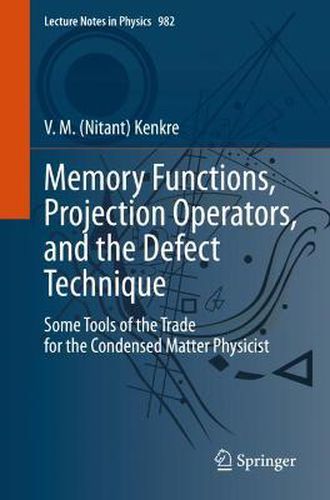Readings Newsletter
Become a Readings Member to make your shopping experience even easier.
Sign in or sign up for free!
You’re not far away from qualifying for FREE standard shipping within Australia
You’ve qualified for FREE standard shipping within Australia
The cart is loading…






This title is printed to order. This book may have been self-published. If so, we cannot guarantee the quality of the content. In the main most books will have gone through the editing process however some may not. We therefore suggest that you be aware of this before ordering this book. If in doubt check either the author or publisher’s details as we are unable to accept any returns unless they are faulty. Please contact us if you have any questions.
This book provides a graduate-level introduction to three powerful and closely related techniques in condensed matter physics: memory functions, projection operators, and the defect technique. Memory functions appear in the formalism of the generalized master equations that express the time evolution of probabilities via equations non-local in time, projection operators allow the extraction of parts of quantities, such as the diagonal parts of density matrices in statistical mechanics, and the defect technique allows solution of transport equations in which the translational invariance is broken in small regions, such as when crystals are doped with impurities. These three methods combined form an immensely useful toolkit for investigations in such disparate areas of physics as excitation in molecular crystals, sensitized luminescence, charge transport, non-equilibrium statistical physics, vibrational relaxation, granular materials, NMR, and even theoretical ecology. This book explains the three techniques and their interrelated nature, along with plenty of illustrative examples. Graduate students beginning to embark on a research project in condensed matter physics will find this book to be a most fruitful source of theoretical training.
$9.00 standard shipping within Australia
FREE standard shipping within Australia for orders over $100.00
Express & International shipping calculated at checkout
This title is printed to order. This book may have been self-published. If so, we cannot guarantee the quality of the content. In the main most books will have gone through the editing process however some may not. We therefore suggest that you be aware of this before ordering this book. If in doubt check either the author or publisher’s details as we are unable to accept any returns unless they are faulty. Please contact us if you have any questions.
This book provides a graduate-level introduction to three powerful and closely related techniques in condensed matter physics: memory functions, projection operators, and the defect technique. Memory functions appear in the formalism of the generalized master equations that express the time evolution of probabilities via equations non-local in time, projection operators allow the extraction of parts of quantities, such as the diagonal parts of density matrices in statistical mechanics, and the defect technique allows solution of transport equations in which the translational invariance is broken in small regions, such as when crystals are doped with impurities. These three methods combined form an immensely useful toolkit for investigations in such disparate areas of physics as excitation in molecular crystals, sensitized luminescence, charge transport, non-equilibrium statistical physics, vibrational relaxation, granular materials, NMR, and even theoretical ecology. This book explains the three techniques and their interrelated nature, along with plenty of illustrative examples. Graduate students beginning to embark on a research project in condensed matter physics will find this book to be a most fruitful source of theoretical training.